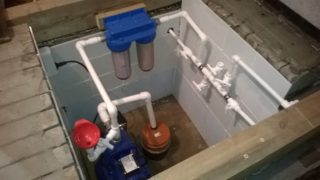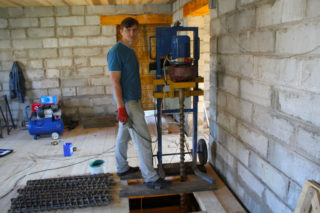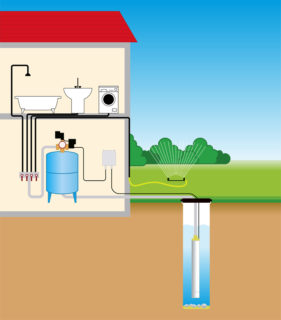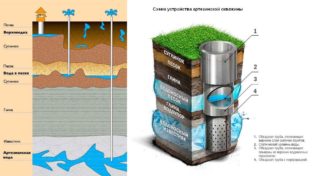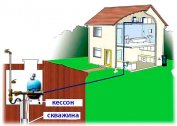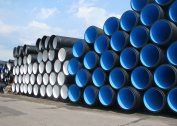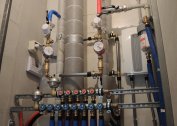When creating an autonomous source of water supply, it is necessary to carry out the installation of a well for water in a private house. At the same time, you need to choose the right location for it - on the construction site or outside it.
Where to place the well
When choosing the location of the well equipment inside the house or on the street, everything should be carefully weighed. Each of the options has a number of its pros and cons. But you need to make a final decision, guided not by momentary benefits, but by a long-term perspective.
Location of the source in the house
More often this decision is made in two cases:
- Completely free building plot. It has neither residential nor utility rooms. As a rule, here the master first determines the location point of the future well, performs drilling, and then designs and builds the house in accordance with the available data.
- Drilling a needle-hole in the basement or cellar of a house. Subject to the availability of a strip foundation and earthen floor. Otherwise, you will have to break up part of the cement screed, which is not very good in terms of waterproofing the lower zone of the building. You can make an Abyssinian well (igloo-well) without the use of heavy equipment. It is enough to simply hammer a pipe with a sharp tip into the soil to the aquifer. As necessary, its length is increased.
A well located on the territory of the house carries such advantages for the master:
- The maximum free area of the land for building, planting. This is especially good if one hundred square meters is extremely small.
- The ability to stretch the wiring of the water supply system at home with minimal cost. The master uses the maximum minimum footage of pipes, it will not be spent on the purchase of insulation for them and on the implementation of heat-saving measures.
- If a well is drilled for water in the house, you do not have to buy a powerful expensive pump, as required by the source device on the street. The unit does not need to transport fluid over large horizontal lengths.
- The top of the casing will never freeze. Since even the basement unheated room of the house has a plus temperature.
Of the minuses of installing a hydraulic structure within the house, there are:
- The inability to form a deep source using special equipment (provided that the master is drilled in the finished building). Here you have to confine yourself to a device with a low flow rate. And this means that there may not be enough water to irrigate.
- Dirty work in the formation of even the Abyssinian well. Not to mention full-fledged drilling.
- Difficulties with the buildup of the finished source after it is drilled in the finished house. By this type of work is meant pumping large volumes of water with admixtures of sand until a clean resource appears. All the selected tonnage of the liquid must be drained somewhere.
- Constant noise of pumping equipment in the basement. Or you have to bear the additional costs of soundproofing the utility room.
- High humidity in the basement. Even with the installation of a sealed head, dampness will sooner or later prevail. And then it will be impossible to fight the fungus. Mold, in turn, will begin to grow underground and higher into the house.
- The inability to adjust special equipment if it is necessary to carry out maintenance work (raising a deep pump, flushing a silted well, etc.).
Any hydraulic structure has a limited life. After its expiration the mine needs to be plugged.It is impossible to do this within the home.
Off-site well location
If you drill a source outside on any part of the site, the work is performed regardless of the season, weather, air temperature. A well is formed using special heavy equipment. Deepen into the ground in one of the ways:
- rotary;
- shock-rope;
- core.
The method is selected by specialists depending on the complexity of the soil, the presence of rocky rocks, quicksand, etc.
The whole process is the installation of a drill, the installation of a special pipe in which drilling is carried out, the withdrawal of drilling drilling fluid into the sump (a special space near the well).
The source located next to the house (outside) has a number of such advantages:
- The ability to drill at any depth, having driven to the site and installing heavy special equipment.
- Formation of a source with a large flow rate (up to an artesian one). There is enough water to supply the house for domestic purposes and for irrigation.
- The ability to arrange a protective caisson, which will eliminate the noise of a working pump on the site. In addition, the camera can be interestingly designed in accordance with the style of landscape design.
- From a street well it’s easier to pull the hose to water the garden.
- The risk of freezing the water supply is also neutralized by using a caisson and draining pipes from it below the freezing level of the soil.
There are fewer drawbacks at the street source than the pros and cons of the well under the house. Here, the main stumbling block is the need for costs for the construction of a caisson, the purchase of a powerful deep-well pump, and the costs of warming the pipeline. Although with modern materials, this can be done on any budget.
Criteria for choosing a well placement method
A master trying to determine the location of a source should rely on such criteria:
- The presence of a finished building on the site. If it is, it is better to give preference to outdoor work. There is a large-scale bridgehead for such work.
- Depth of the alleged source. If you plan to drill to the first aquifer in order to use the liquid for technical purposes (in the country, for example), you can hammer the Abyssinian needle-hole in the basement. Deeper shafts are best drilled outside.
- The possibility of fitting special equipment to the well not only here and now, but also in the future. If at the moment the drilling rig enters the site from the side of the neighboring undeveloped allotment, it will be bought later. It is unlikely that the neighbors will want to pass a powerful car through their well-groomed lands.
- Possible financial expenses for drilling. At the stage of a building that is still under construction, the cost of installing an “internal” well and a water supply system will be two times lower than the cost of external work. If the house is already ready, making a well in it will be twice as expensive as on the street.
- The need for long-term operation of the source. More often, the hydraulic structure inside the building works shorter than the street. Therefore, those who plan to sell the plot later drill in the house.
If you want to position the well inside the building, it is better to build greenhouses, farm buildings, a garage, a cellar above it. And it is desirable so that, if necessary, they can be quickly disassembled for repair, technical, maintenance work.
Summarizing
If we summarize the above arguments, it turns out that in the short term (investments, labor costs, source productivity) it is more profitable to drill a mine in the basement of the house or with the further construction of the building above it. For the long term, it’s more profitable to mount the well outside. It is important to comply with several key recommendations:
- from the building to the source you need to withstand at least 3 meters;
- a good location for drilling - the border with a car entrance (4-6 meters), in extreme cases, you can provide a removable section of the gate;
- it is forbidden to drill under power lines (especially high-voltage ones); this threatens serious injuries for the craftsmen and the owners of the site in the future;
- you can make a well in a dried well, but such a technique will cost more.
No need to risk your future well-being for the sake of momentary benefits, and to drill a source on the site of an unfinished house.
